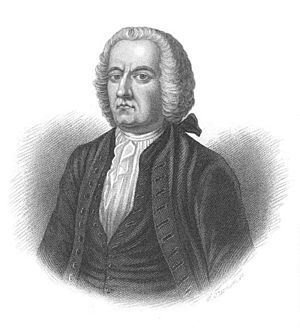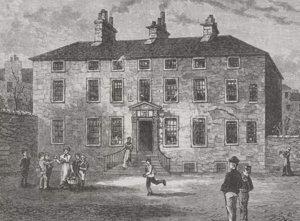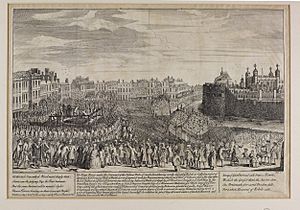Arthur Elphinstone, 6th Lord Balmerino facts for kids
Quick facts for kids
Arthur Elphinstone, 6th Lord Balmerino
|
|
|---|---|

Lord Balmerino; 19th century reproduction of a contemporary print
|
|
| Born | Arthur Elphinstone 1688 Leith |
| Died | 18 August 1746 (aged 57–58) Tower Hill, London |
| Cause of death | Execution by beheading |
| Resting place | St Peter ad Vincula |
| Tenure | 1746 |
| Nationality | Scots |
| Residence | Balmerino House, Leith |
| Wars and battles | 1715 Jacobite Rising Sheriffmuir 1745 Jacobite Rising Prestonpans Falkirk Culloden |
| Spouse(s) | Margaret Chalmers |
| Parents | John, 4th Lord Balmerino Anne Ross |
|
|
|
Arthur Elphinstone, the 6th Lord Balmerino and 5th Lord Cupar (born in 1688, died August 18, 1746), was a Scottish nobleman. He was a Jacobite, meaning he supported the claim of the exiled House of Stuart royal family to the British throne.
As a military officer, he served in both the British and French armies. He also took part in Jacobite rebellions in 1715 and 1745. After the first rebellion, he spent almost 20 years living in other countries. He was later forgiven for his actions. However, after the 1745 rebellion failed at the Battle of Culloden, he was captured. He was accused of treason (betraying his country) and executed in Tower Hill.
Historians often call him Lord Balmerino when talking about the 1745 rebellion. But he only inherited this title in January 1746. For most of his life, he was known as "the Hon. Arthur Elphinstone."
Contents
Arthur Elphinstone's Early Life
Arthur Elphinstone was born in Leith, Scotland. His father was John Elphinstone, the 4th Lord Balmerino. His mother was Anne Ross, who was the daughter of Arthur Rose, the Archbishop of St Andrews. Arthur lived in Balmerino House in Leith for most of his life.
His family came from James Elphinstone (around 1553–1612). James was a younger son of Robert Elphinstone, 3rd Lord Elphinstone. In 1605, King James VI and I gave James Elphinstone the lands of Balmerino Abbey in Fife. Over time, the family's land shrunk due to legal battles. By the 1700s, they only owned the area of Restalrig in South Leith.
The Elphinstone family were important members of the Episcopalian group in Scotland. This group was a minority. Many Scottish Episcopalians were conservatives. They believed that removing the Stuart kings was wrong. They also opposed the Union of England and Scotland in 1707.
Arthur had three older half-brothers from his father's first marriage. Hugh died in 1708 during the Siege of Lille. James (1675–1746) became a lawyer and judge. Alexander died in 1733. Arthur was not expected to inherit the family's estate. So, he decided to join the military. He became a captain in Lord Shannon's regiment in March 1714.
Arthur Elphinstone's Role in Jacobite Rebellions
Arthur Elphinstone was a strong supporter of the Jacobite cause. He was an Episcopalian Protestant from Scotland's northeast. Many people like him believed the Stuart kings should be on the throne.
During the 1715 Jacobite Rising, he first fought for the government. This was at the Battle of Sheriffmuir. However, he felt it was "against his conscience." So, he left the government side and joined the Jacobites. After the rebellion failed, he fled Scotland. He might have gone to Denmark before joining the French army.
In 1733, Arthur's father helped him get a pardon. This meant he was forgiven for his past actions. He eventually returned to Scotland. Around this time, he married Margaret Chalmers. She was the daughter of a Captain Chalmers from Leith. His half-brother James became Lord Balmerino after their father died in 1736.
Arthur Elphinstone was one of the first people to join Charles Edward Stuart. This was during Charles's 1745 attempt to regain the British throne for the Stuarts. His past Jacobite activities were a clear reason for him joining. Some people also thought his family's financial problems meant he had little to lose.
He was given command of a troop in Charles's "Life Guard." This was alongside David Wemyss, Lord Elcho. Unlike many other senior Jacobites, no one criticized him in their writings after the rebellion. John Daniel, who worked with him in 1745, praised his loyalty, courage, and language skills. He also noted that Arthur's memory was "wonderful" for his age.
Arthur became the 6th Lord Balmerino on January 5, 1746. This happened after his half-brother James died. However, in April of the same year, he was captured at the Battle of Culloden.
Trial and Execution
Lord Balmerino was put on trial before Parliament. William Boyd, 4th Earl of Kilmarnock and George Mackenzie, 3rd Earl of Cromartie were also tried. Because of his past and previous pardon, he defended himself. He didn't offer much of a defense. He even joked that he only pleaded not guilty so "so many ladies might not be disappointed of their show."
He was found guilty of treason. He was then stripped of his titles and lands. He was executed by beheading on the same day as the Earl of Kilmarnock.
Lord Balmerino went to his execution without regret. He famously said, "If I had a thousand lives, I would lay them all down in the same cause." His calm and humorous attitude during his trial and execution was widely reported. He joked with people watching. He even insisted on taking the axe in his carriage so Kilmarnock wouldn't be bothered by it.
Horace Walpole, a famous writer, described him as "the most natural brave old fellow I ever saw." He said Balmerino acted like a soldier and a man during his trial. He was buried in the Church of St Peter ad Vincula in the Tower of London. This was reportedly at his own request, next to William Murray, Marquess of Tullibardine.
His home, Balmerino House in Leith, was taken by the Crown. The Crown also took over his support of South Leith Parish Church. In 1755, the Crown sold Balmerino House to James Stuart, 8th Earl of Moray. It was sold again several times. In 1848, it was sold to the Catholic Church for £1800. They used the land to build a convent and a Roman Catholic church.
Family
Arthur Elphinstone was married to Margaret Chalmers. She was the daughter of Captain Chalmers of Leith. They did not have any children.



